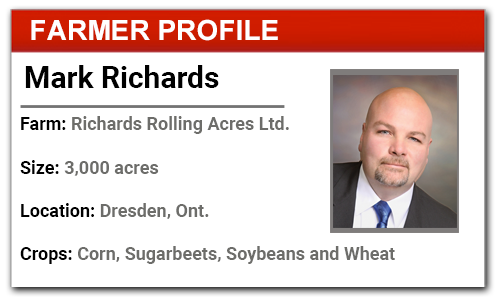
Mark Richards has deep experience with precision farming equipment, which complements his overall farming philosophy of being a “smart” steward of his operation.
Starting with no-till in 1996, he soon became interested in strip-till to help give crops on his southern Ontario-based farm a boost in the early spring. Richards no-tills his soybeans and wheat and strip-tills corn, sugarbeets and tomatoes.
“We tried strip-tillage in 2010, borrowing a friend’s 4-row Orthman 1tRIPr. Before that, sugarbeet ground was worked 3 times before planting and that was too much tillage,” he says. “Now, we strip till wheat in the fall prior to planting the sugarbeets. It greatly improves water infiltration and reduces our fuel costs by 40% . Due to the self-propelled beet harvesters, 80% of the time, we are able to pull strips without any other tillage for corn the following year.”
Richards uses a hybrid system of sorts for precision steering and variable-rate fertilizer application. He has two strip-till units; a 12-row 1tRIPr followed by a Montag fertilizer tank that feeds fertilizer to a double-tillage coulter in each row for corn and sugarbeets. “We use a two-pass strip –till system, applying potash (K) behind a shank in the fall and phosphorus (P) and nitrogen (N) blended in a strip tillage pass in the spring,” he says.
The John Deere GreenStar 2630 controller follows an RTK signal for auto-steering and sends variable-rate fertilizing information to his Dickey-john IntelliAg virtual monitor to control flow to each row unit.
“It was half the price of a Deere system and can variable-rate up to 4 products at once,” Richards says.
The 12-row strip-till rig is 3-point hitch mounted so additional draft controllers aren’t needed. However, it does have gyroscope-driven Tilt Control Modules that help compensate for uneven terrain.
His 6-row strip tillage unit for tomatoes is a pull-type unit outfitted with a ProTrakker hitch to maintain row accuracy. His corn planter is a center-post Kinze 2600 12-row pull-type unit.
“I like this design because it pulls straight and drafts well,” he says. He also appreciates that its width matches his strip-till unit, so he is able to control traffic in corn.
“After tomatoes, I usually rotate to wheat to help alleviate compaction from field traffic,” Richards says. “We are on a 5-year rotation with tomatoes. It’s the most profitable crop we have, but the harvesters greatly affect the soil.”
Point of Pain: Short Supply of Qualified Expertise
Early on, Richards was also a subdealer for some precision equipment and handled service calls as well. Most of the time, it was a matter or operator malfunction.
“Customers didn’t read the manual or even fully understand what the unit could — and couldn’t — do,” he says. “As I am considering upgrading precision equipment, I work to learn as much about it as I can even before I make a decision to purchase it. It goes a long way in minimizing problems in the spring or the fall,”
The shortage of qualified service technicians can exacerbate problems in the field. Richards notes that technology is evolving rapidly and good precision technicians move around a lot.
“There is a lot of demand for their expertise. I have stayed in contact with technicians as far away as South Dakota because they know their equipment,” Richards says. “On the other hand, one local technician who only works with Deere systems can’t provide much help when it comes to getting the GS 2630 to talk with my Dickey-john rate controllers. That can be frustrating.”


![[Technology Corner] Autonomy & Robotics Take Center Stage](https://www.precisionfarmingdealer.com/ext/resources/2026/01/12/Autonomy--Robotics-Take-Center-Stage.webp?height=290&t=1768253759&width=400)


